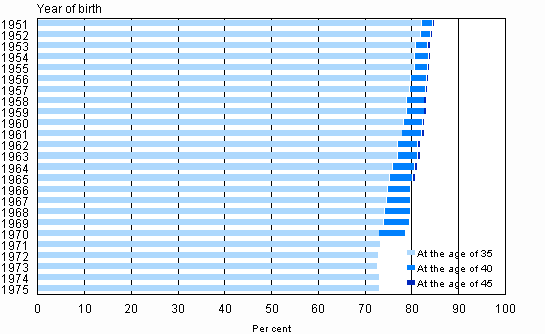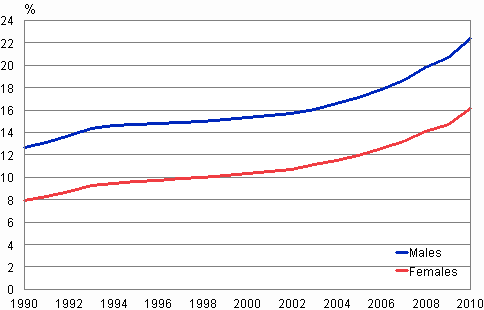Published: 30 September 2011
One 40-year-old woman in five has no children
According to Statistics Finland's statistics on the population structure, 21 per cent of the 40-year-old women resident in Finland have not given birth to a child. The proportion of women without children has been growing slowly but constantly. In 1990, the share of 40-year-old women without children was 15 per cent.
Share of 35, 40 and 45-year-old women having given birth among women born in 1951 to 1975

The starting of a family is being postponed to an ever later age. In 1990, the share of mothers among 30-year-old women was 67 per cent. At the end of 2010, only around one 30-year-old woman in two had become a mother. If this development continues, there is a threat of an ever growing share of women remaining totally childless in future.
In Ostrobothnia, the share of those without children among 40-year-old women was 15 per cent at the end of 2010. In the region of Uusimaa, one 40-year-old woman in four has no children. Among the women living in Helsinki, 36 per cent have not given birth to a child.
The marital status of 29 per cent of all 40-year-old women was unmarried, while 57 per cent were married and 13 per cent divorced. Two out of three of the 40-year-old women with no children were unmarried, one in four were married and 8 per cent were divorced.
Persons with no religious affiliation already number over one million
The Population Information System includes data on whether a person is member of a religious community registered in Finland. The number of persons with no religious affiliation exceeded the one million mark in 2010. Thus, nearly every fifth person in Finland is not a member of a religious community registered in Finland. The number of persons with no religious affiliation has doubled in two decades.
Share of persons not belonging to religious communities by gender 1990–2010

Share of persons with no religious affiliation is highest in Uusimaa and lowest in South Ostrobothnia
At the end of 2010, there were 1,032,429 persons with no religious affiliation. The share of those with no religious affiliation was clearly higher among men, at 22 per cent, than among women, 16 per cent. There were also large regional differences. In the region of Uusimaa, the share of population with no religious affiliation was 27 per cent, while in South Ostrobothnia the respective share was nine per cent.
Only one foreign-language speaker out of five is member of a religious community registered in Finland
42 per cent of the 25 to 34-year-old men living in the region of Uusimaa are not members of any religious community. Of the foreign-language speaking population resident in Finland, 82 per cent are not members of any religious community registered in Finland. Among the 25 to 39-year-old foreign-language speaking men, the share is nearly 90 per cent.
At the end of 2010, 78 per cent of the population belonged to the Evangelical Lutheran Church of Finland. One per cent were members of the Orthodox Church of Finland and another one per cent belonged to some other religious communities. At the end of 1980, 90 per cent of the population belonged to the Evangelical Lutheran Church of Finland.
Source: Population Structure 2010, Statistics Finland
Inquiries: Markus Rapo (09) 1734 3238, vaesto.tilasto@stat.fi
Director in charge: Jari Tarkoma
Publication in pdf-format (430.3 kB)
- Reviews
- Tables
-
Tables in databases
Pick the data you need into tables, view the data as graphs, or download the data for your use.
Appendix tables
- Appendix table 1. Sizes of municipalities by region 31.12.2010 (30.9.2011)
- Appendix table 2. Married women by duration and order of marriage 31.12.2010 (30.9.2011)
- Appendix table 3. Females aged 15 - 75 by number of live-born children 31.12.2010 (30.9.2011)
- Appendix table 4. Males aged 15 - 75 by number of live-born children 31.12.2010 (30.9.2011)
- Appendix table 5. Women by age, number of children and the proportion of birth 31.12.2010 (30.9.2011)
- Appendix table 6. Males by age and number of children 31.12.2010 (30.9.2011)
- Appendix table 7. Religious affiliation of the population by age and sex 31.12.2010 (30.9.2011)
- Appendix table 8. Religious affiliation of the population 2003 - 2010 (30.9.2011)
- Figures
-
- Appendix figure 1. Swedish-speakers' proportion of the population in 1900 - 2010 (30.9.2011)
- Appendix figure 2. Demographic dependency ratio in 1950 - 2010 and projection for 2011 - 2050 (30.9.2011)
- Appendix figure 3. Proportions of the regions in total population in 2010 (30.9.2011)
- Appendix figure 4. Foreign born population by region in 2009 and 2010 (30.9.2011)
- Quality descriptions
-
- Quality description: Population structure 2010 (30.9.2011)
Updated 30.9.2011
Official Statistics of Finland (OSF):
Population structure [e-publication].
ISSN=1797-5395. annual review 2010. Helsinki: Statistics Finland [referred: 19.12.2025].
Access method: http://stat.fi/til/vaerak/2010/01/vaerak_2010_01_2011-09-30_tie_001_en.html

